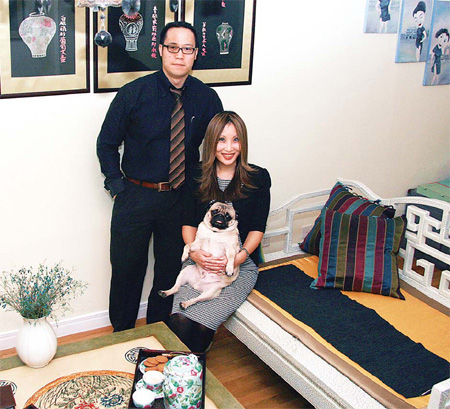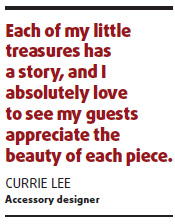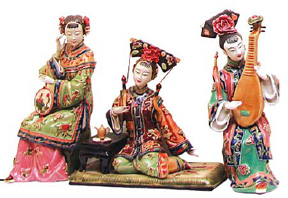Expats
Treasuring the art of life
By Alexandra Leyton Espinoza (China Daily)
Updated: 2010-01-20 09:54
 |
Large Medium Small |
|
 Currie Lee and her husband Greg in front of hand-embroidered works by Currie's great-grandmother in their living room. |
Expat accessory designer Currie Lee spends the working day at her boutique in the heart of Sanlitun but lives 20 km and a world away in a three-story home in the quiet suburbs of Shunyi filled with an eclectic blend of items collected from around the world.
"I prefer the busy cosmopolitan life, but (my husband) Greg was raised in a big house with a big backyard," she said.
Together with their pug pup Chelli and two cats Nibbi and Cheeto, the couple has been living in their new home for just four months after moving from an apartment in Jianwai SOHO, but the house is already rich with mementos from their wedding, trips around the world, and gifts and heirlooms from family and friends.
One wedding gift is a vintage ceramic plate with a duck painted on it. It's given to them by an Italian owner and chef in Verona, Italy, where the couple was married.
"I have always been fascinated by Italy," said the 31-year-old designer, whose bags and jewelry are made from recycled, natural and ethnic materials.
"Verona is the setting of Romeo and Juliet and full of romance. So for us it was precious to be married there,"
Six hand-embroidered pieces in elegant black frames adorn the walls of their living room, each symbolic of Korea's six dynasties.
The oldest three were embroidered by Currie's great-grandmother and given as a gift to her mother-in-law.
The others were made by her grandmother.
A jade-green celadon vase placed atop a cabinet in the hallway is another of her treasures.
"It was a copy made personally for my father from the original, which was unearthed by him when he had the opportunity of accompanying an archaeologist friend on the dig," she said.
The couple has travelled extensively, each time bringing home something from the places they visited. On a trip to Yunnan, they decided not to follow the tourist crowd and instead visited the Bulang minority community, which has retained much of their original music, clothing and traditional way of life.
During their stay, they purchased an erhu musical instrument made of snakeskin and wood.
Another part of their collection is turquoise-colored pair of Kripal kumbh jewelry boxes made by the Indian pottery designer Kripal Singh, who created a fresco on the life of Mahatma Gandhi in Birla House, Gandhi's home in New Delhi. He is one of the few remaining potters still handcrafting the traditional blue pottery native to Jaipur, a city in India.
From the bazaars of Delhi, Currie returned with various silk sari fabrics. Her favorite is jamava silk shawls made in Kashmir, which she uses in her new collection of clutch bags. The bags are also studded with semi-precious stones from Jaipur.

"I love the vibrant colors of peacock feathers, especially the richness of the turquoise, gold and emerald," she said. "They are the most gorgeous colors found in mother nature. They are my inspiration."
In the dinning room, the table is made purely of glass, as are the matching chairs and chandelier. They were custom-made for their apartment in Jianwai SOHO, as was the other furniture in her home.
"I tell all my friends not to buy furniture," she said.
"Custom-made furniture is relatively affordable and there are quite a few very good craftsmen, especially from southern China. All you need is a bit of creativity."
A cabinet adorned by a mask purchased during a Venetian carnival masquerade hides her cavernous collection of stiletto shoes.
The mask in white and gold together with even more peacock feathers adds a touch of burlesque glamour.
On the second floor is Currie's workplace where many of her designs are created. A large calligraphy scroll of Buddhist scripture, written in the rare Korean yae chae style by her grand uncle, takes center stage as one of the most important items in the home.
"Very few people are able to read it, including myself, but it's one of my most precious items," she said.
From Bangkok, they brought back a baan baat, or handcrafted monk's begging bowl laboriously hammered in copper, which now shines in a corner of the room.

"This is a dying tradition, as the baan baat is being replaced by mass-produced stainless steel bowls - another example of a tradition at risk from 'modernization'," she said.
Next to the bowl are shoes made of wood and a ho-rong paper lamp stand, from her great-grandmother's time.
"It's absolutely necessary to find handcrafted pieces with cultural and traditional significance rather than monetary value during my travels, especially those at risk of dying out and being forgotten," she said.
"Each of my little treasures has a story, and I absolutely love to see my guests appreciate the beauty of each piece."








